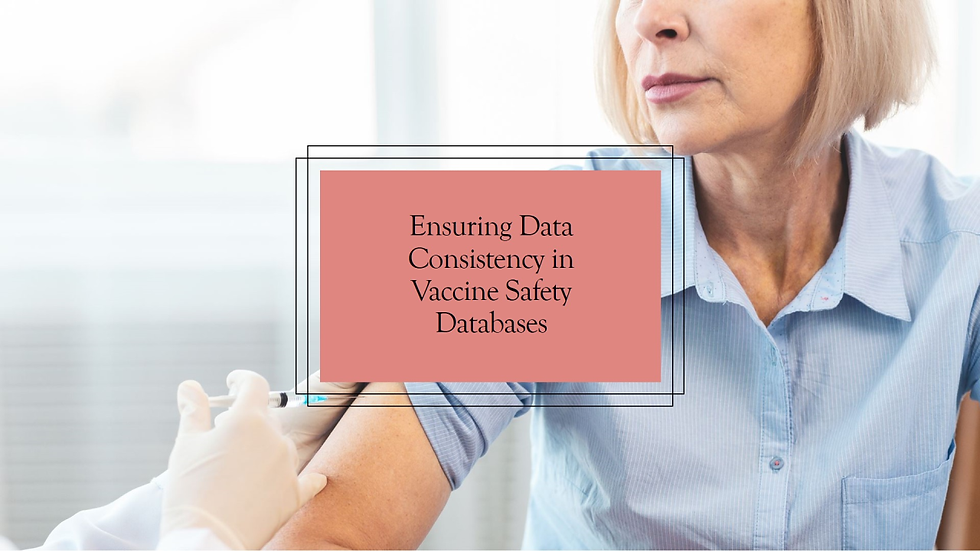How to Ensure Data Consistency in Vaccine Safety Databases
- Chaitali Gaikwad
- Jun 27, 2024
- 4 min read

Vaccine safety databases serve as repositories of critical information related to vaccine administration and adverse event monitoring. Consistent data ensures that healthcare providers, regulatory agencies, and researchers can rely on accurate information to make informed decisions about vaccination programs.
Importance of Data Consistency:
1. Reliable Surveillance and Monitoring
Early Detection: Consistent data allows for timely identification of adverse events and safety signals associated with vaccines.
Effective Response: Facilitates prompt response and intervention strategies to mitigate risks and ensure public health safety.
2. Evidence-based Decision-making
Accurate Analysis: Ensures the reliability of data analysis and interpretation for evidence-based policy-making and regulatory decisions.
Risk Assessment: Enables thorough assessment of vaccine safety profiles and identification of potential risks across different populations.
3. Public Trust and Confidence
Transparency: Consistent data promotes transparency in vaccine safety monitoring, enhancing public trust in immunization programs.
Accountability: Ensures accountability among healthcare providers and regulatory agencies for maintaining high standards of vaccine safety.
Strategies for Ensuring Data Consistency:
1. Standardized Data Collection Practices
Unified Reporting Standards: Establish standardized protocols and formats for data entry and reporting across healthcare facilities and jurisdictions.
Quality Control Measures: Implement validation checks and data quality assessments to identify and rectify inconsistencies proactively.
2. Integration and Interoperability
Data Integration: Integrate data from diverse sources, such as electronic health records (EHRs), pharmacovigilance systems, and patient registries, into centralized databases.
Interoperability: Ensure compatibility and seamless data exchange between different healthcare information systems to maintain data consistency.
3. Real-time Data Updates
Continuous Monitoring: Implement real-time data synchronization and updates to capture new adverse events and emerging safety signals promptly.
Automated Alerts: Utilize automated alerts and notifications for healthcare providers and regulators to ensure timely response to critical data updates.
Challenges in Ensuring Data Consistency:
1. Data Quality and Integrity
Incomplete Reporting: Address gaps and inconsistencies in data reporting and documentation practices among healthcare providers.
Data Validation: Validate the accuracy and completeness of data entries to minimize errors and discrepancies.
2. Technological Infrastructure
Resource Constraints: Invest in robust IT infrastructure and data management systems capable of handling large volumes of vaccine safety data.
Security Concerns: Implement measures to safeguard data privacy and protect against unauthorized access or breaches.
3. Regulatory Compliance and Governance
Compliance Standards: Adhere to regulatory guidelines and standards (e.g., GDPR, HIPAA) for data privacy, security, and ethical use in vaccine safety surveillance.
Ethical Considerations: Ensure ethical practices in data collection, storage, and dissemination to uphold patient confidentiality and rights.
Benefits of Data Consistency in Vaccine Safety Databases:
1. Improved Data Accuracy
Reliable Analysis: Enhance the accuracy and reliability of data analysis for identifying trends, patterns, and correlations in vaccine safety outcomes.
Confident Decision-making: Enable stakeholders to make informed decisions based on trustworthy and consistent data insights.
2. Efficient Resource Allocation
Optimized Interventions: Allocate resources effectively for monitoring and responding to vaccine safety concerns based on accurate data.
Cost Savings: Reduce operational costs associated with data reconciliation and error correction processes.
3. Enhanced Public Health Outcomes
Effective Risk Management: Mitigate risks and adverse events promptly through proactive surveillance and intervention strategies.
Public Trust: Foster public confidence in vaccination programs by demonstrating transparency and accountability in data management practices.
Best Practices for Maintaining Data Consistency:
1. Training and Education
Healthcare Provider Training: Provide training on standardized data collection protocols, adverse event reporting, and data quality assurance.
Continuous Learning: Foster a culture of continuous learning and improvement among healthcare professionals involved in vaccine safety surveillance.
2. Quality Assurance Measures
Data Audits: Conduct regular audits and quality assessments to ensure compliance with data standards and regulatory requirements.
Feedback Mechanisms: Solicit feedback from stakeholders to identify areas for improvement in data consistency and management practices.
3. Collaboration and Communication
Interagency Collaboration: Foster collaboration among healthcare providers, regulatory agencies, and vaccine manufacturers to share best practices and enhance data consistency.
Transparent Communication: Maintain open communication channels with the public about data collection processes, safety monitoring efforts, and regulatory updates.
Future Trends in Data Consistency Management:
1. Advancements in Technology
AI and Machine Learning: Utilize AI-driven algorithms for automated data validation, anomaly detection, and predictive analytics in vaccine safety databases.
Blockchain Technology: Implement blockchain solutions for secure and transparent data management, enhancing data integrity and traceability.
2. Global Harmonization
Standardization Efforts: Participate in international initiatives to establish harmonized data standards and interoperable vaccine safety databases across countries.
Cross-border Collaboration: Strengthen global partnerships for sharing vaccine safety data and facilitating collaborative research on global health challenges.
3. Ethical and Regulatory Frameworks
Ethical Guidelines: Develop and adhere to ethical guidelines for responsible data stewardship, respecting patient rights and privacy in vaccine safety surveillance.
Regulatory Compliance: Stay updated with evolving regulatory requirements and guidelines to ensure compliance in data management practices.
Conclusion:
Ensuring data consistency in vaccine safety databases is essential for maintaining the integrity and reliability of information used in monitoring and managing vaccine safety during pandemics and beyond. By implementing standardized practices, leveraging advanced technologies, and fostering collaboration among stakeholders, healthcare systems can enhance their capacity to detect, respond to, and mitigate vaccine-related risks effectively. Continuous improvement in data consistency management will contribute to achieving better public health outcomes and promoting trust in vaccination as a critical tool in disease prevention and control.




Comments